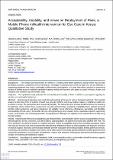| dc.contributor.author | Lodhia, Vaishali | |
| dc.contributor.author | Karanja, Sarah | |
| dc.contributor.author | Lees, Shelley | |
| dc.contributor.author | Bastawrous, Andrew | |
| dc.date.accessioned | 2021-08-25T09:38:31Z | |
| dc.date.available | 2021-08-25T09:38:31Z | |
| dc.date.issued | 5/9/2016 | |
| dc.identifier.citation | Lodhia V, Karanja S, Lees S, Bastawrous A Acceptability, Usability, and Views on Deployment of Peek, a Mobile Phone mHealth Intervention for Eye Care in Kenya: Qualitative Study JMIR mHealth uHealth 2016;4(2):e30 URL: http://mhealth.jmir.org/2016/2/e30/ doi: 10.2196/mhealth.4746 PMID: 27160779 | en_US |
| dc.identifier.issn | 2291-5222 | |
| dc.identifier.uri | http://repository.amref.org/handle/123456789/139 | |
| dc.description | ©Vaishali Lodhia, Sarah Karanja, Shelley Lees, Andrew Bastawrous. Originally published in JMIR Mhealth and Uhealth (http://mhealth.jmir.org), 09.05.2016.
This is an open-access article distributed under the terms of the Creative Commons Attribution License (http://creativecommons.org/licenses/by/2.0/), which permits unrestricted use, distribution, and reproduction in any medium, provided the original work, first published in JMIR mhealth and uhealth, is properly cited. The complete bibliographic information, a link to the original publication on http://mhealth.jmir.org/, as well as this copyright and license information must be included. | en_US |
| dc.description.abstract | Background:
The Portable Eye Examination Kit (Peek) is a mobile phone–based ophthalmic testing system that has been developed to perform comprehensive eye examinations. Shortages in ophthalmic personnel, the high cost, and the difficulty in transporting equipment have made it challenging to offer services, particularly in rural areas. Peek offers a solution for overcoming barriers of limited access to traditional ophthalmic testing methods and has been pilot tested on adults in Nakuru, Kenya, and compared with traditional eye examination tools.
Objective:
This qualitative study evaluated the acceptability and usability of Peek in addition to perceptions regarding its adoption and nationwide deployment.
Methods:
Semistructured interviews were conducted with patients and analyzed using a framework approach. This included analysis of interviews from 20 patients, 8 health care providers (HCPs), and 4 key decision makers in ophthalmic health care provision in Kenya. The participants were purposefully sampled. The coding structure involved predefined themes for assessing the following: (1) the context, that is, environment, user, task, and technology; (2) patient acceptability, that is, patients' perceived benefits, patient preference, and patient satisfaction; (3) usability, that is, efficiency, effectiveness, learnability, and flexibility and operability of Peek; and (4) the benefits of Peek in strengthening eye care provision, that is, capabilities enhancer, opportunity creator, social enabler, and knowledge generator. Emerging themes relating to the objectives were explored from the data using thematic analysis.
Results:
Patients found Peek to be acceptable because of its benefits in overcoming the barriers to accessing ophthalmic services. Most thought it to be fast, convenient, and able to reach a large population. All patients expressed being satisfied with Peek. The HCPs perceived it to satisfy the criteria for usability and found Peek to be acceptable based on the technology acceptance model. Peek was also found to have features required for strengthening ophthalmic delivery by aiding detection and diagnosis, provision of decision support, improving communication between provider and patient and among providers, linking patients to services, monitoring, and assisting in education and training. Some of the deployment-related issues included the need for government and community involvement, communication and awareness creation, data protection, infrastructure development including capacity creation, and training and maintenance support.
Conclusions:
According to all parties interviewed, Peek is an acceptable solution, as it provides a beneficial service, supports patients' needs, and fulfills HCPs' roles, overall contributing to strengthening eye health. | en_US |
| dc.description.sponsorship | British Council for the Prevention of Blindness, the Medical Research Council, the Department for International Development, Fight for Sight, the International Glaucoma Association, and The Queen Elizabeth Diamond Jubilee Trust | en_US |
| dc.language.iso | en | en_US |
| dc.publisher | JMIR MHEALTH AND UHEALTH | en_US |
| dc.title | Acceptability, Usability, and Views on Deployment of Peek, a Mobile Phone mHealth Intervention for Eye Care in Kenya: Qualitative Study | en_US |
| dc.type | Article, Journal | en_US |

